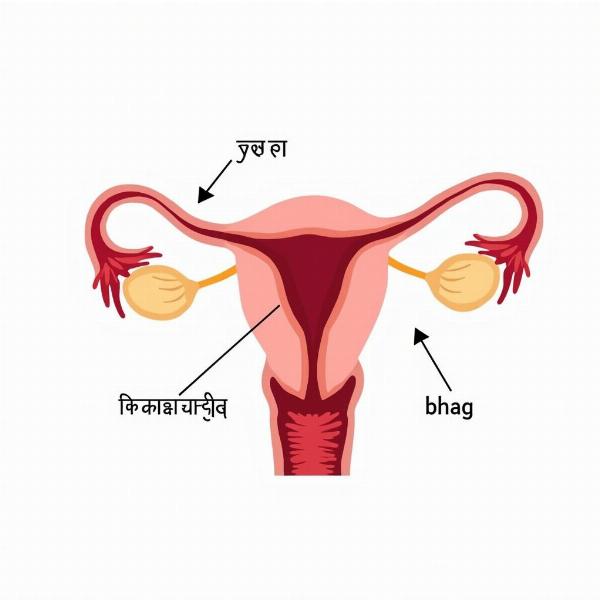Understanding the Hindi terms for private body parts is crucial for clear communication, especially in contexts like healthcare, education, and personal safety. This guide provides a comprehensive overview of these terms, focusing on accuracy and cultural sensitivity.
Common Terms for Private Body Parts in Hindi
Knowing the correct terminology can empower individuals to discuss sensitive topics with confidence and respect. This section outlines some of the most frequently used Hindi words for private body parts.
-
For Males: The most common term for the male genitalia is ling (लिंग). Other terms include shishan (शिश्न) and jananaindriya (जननांग), which refers to the reproductive organs in general.
-
For Females: The female genitalia is often referred to as yoni (योनि), which has spiritual and symbolic connotations in addition to its anatomical meaning. Jananaindriya (जननांग) also applies to female reproductive organs, and bhaag (भाग) can be used colloquially.
 Female Private Parts in Hindi
Female Private Parts in Hindi -
Gender-Neutral Terms: Guptang (गुप्त अंग) meaning “hidden parts” is a gender-neutral term for private body parts. This term is widely understood and considered polite in various social settings.
Importance of Using Correct Terminology
Using the right words is essential for effective communication. It avoids misunderstandings and promotes respectful dialogue. Incorrect or overly casual language can be offensive and create unnecessary discomfort.
Cultural Sensitivity and Respect
Discussions about private body parts require sensitivity and respect. It’s important to remember that cultural norms and beliefs surrounding these topics vary significantly. Using appropriate language demonstrates respect for individual privacy and cultural values.
Why Knowing These Terms Matters
Knowing these terms can be extremely helpful in many situations, particularly in medical settings. Being able to clearly communicate with healthcare professionals ensures accurate diagnosis and treatment. It also empowers individuals to discuss their health concerns confidently.
What are some alternative terms for private body parts in Hindi?
While the terms listed above are common, several alternative words exist with varying degrees of formality and regional usage. Some examples include sharamgah (शर्मगाह) which translates to “place of modesty,” and specific anatomical terms used primarily in medical contexts.
How do I use these terms respectfully in conversation?
Context matters. When discussing these topics, maintain a tone of respect and avoid using slang or overly casual language. Using gender-neutral terms like guptang when appropriate can be a good approach.
Where can I find more information on human anatomy in Hindi?
Several online resources and educational materials provide detailed information about human anatomy in Hindi. You can also consult medical dictionaries and textbooks for more specialized terminology.
Conclusion
Understanding the appropriate Hindi terms for private body parts is essential for clear and respectful communication. This guide has provided a comprehensive overview of these terms, emphasizing cultural sensitivity and accuracy. By using the correct language, we can promote open and healthy conversations about important topics related to health, education, and personal well-being. Remember to always communicate with respect and sensitivity.
FAQ
-
What is the most polite way to refer to private body parts in Hindi? Guptang (गुप्त अंग) is a widely understood and polite gender-neutral term.
-
Are there different terms used for male and female private parts? Yes, terms like ling (लिंग) and yoni (योनि) are specific to males and females, respectively.
-
Why is it important to use correct terminology when discussing these topics? Using the correct terminology ensures clear communication, avoids misunderstandings, and demonstrates respect.
-
Where can I learn more about respectful communication regarding private body parts? Educational resources and healthcare providers can offer guidance on sensitive communication.
-
What should I do if I’m unsure of the appropriate term to use? Using a more general term like guptang (गुप्त अंग) or seeking clarification from a trusted source is recommended.
-
Are there regional variations in the terminology used? Yes, some terms might be more common in certain regions of India.
-
How can I ensure I’m being culturally sensitive when discussing these topics? Being mindful of cultural norms and beliefs surrounding these topics and using respectful language is crucial.
Meaning-Hindi.in is your trusted partner for accurate and culturally sensitive Hindi translations. We specialize in various translation services, including business and commercial documents, legal and certified translations, technical manuals, website localization, and educational materials. Our expert linguists ensure that your message is conveyed accurately and respectfully in Hindi. For high-quality Hindi translation services, contact us at [email protected] or call +91 11-4502-7584. Meaning-Hindi.in helps bridge the language gap and connect you with your target audience effectively.